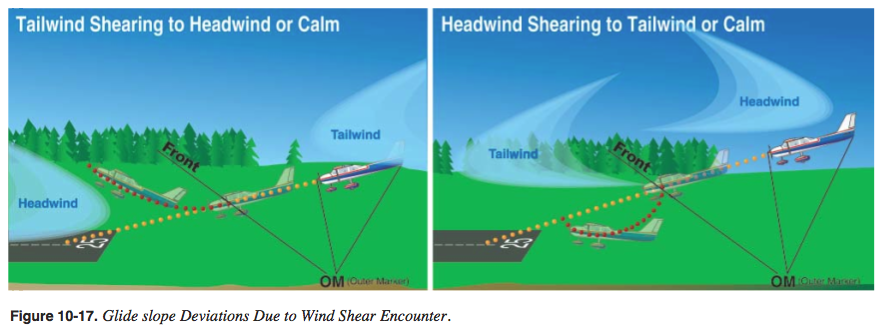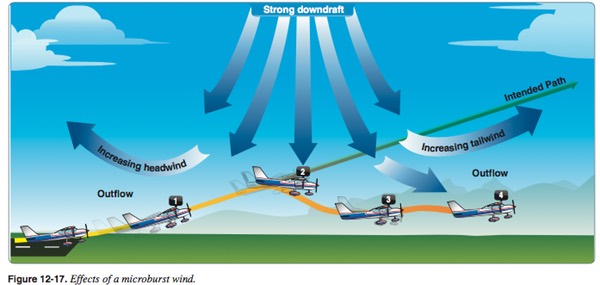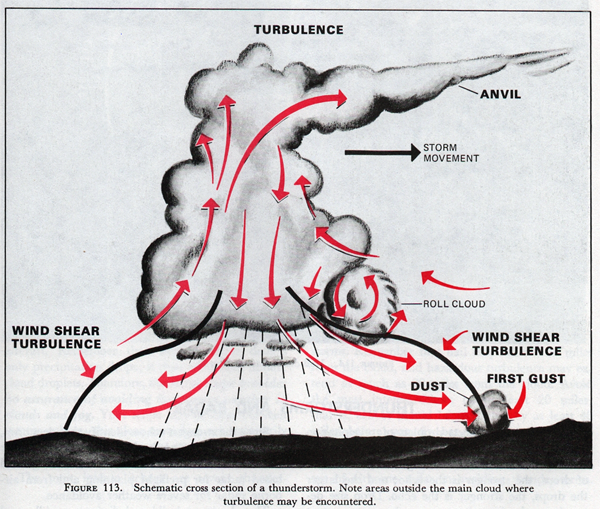Wind Shear
The Aviation Safety Network database contains 69 wind-shear accidents, most of which did not result in fatalities. Three accidents—New Orleans in 1975, New York in 1982, and Dallas-Fort Worth crash in 1985—prompted NASA to begin a program to understand and detect wind shear. As a result of the program, wind-shear alert systems have been installed at over 100 large airports and airliners are required to have on-board wind-shear sensor systems. There has only been one wind-shear accident in airliners in the US since the sensors were installed. (Charlotte, NC). The NTSB database lists 127 accidents where wind shear was listed in the probable causes.
There are several questions on wind shear on the FAA Knowledge tests, especially on the Instrument Test. The questions can be answered by referring to several FAA publications.
Instrument Flying Handbook p 10-25
Wind shear can be defined as a change in wind speed and/or wind direction in a short distance. It can exist in a horizontal or vertical direction and occasionally in both. Wind shear can occur at all levels of the atmosphere but is of greatest concern during takeoffs and landings. It is typically associated with thunderstorms and low-level temperature inversions; however, the jet stream and weather fronts are also sources of wind shear.
As Figure 10-17 illustrates,  while an aircraft is on an instrument approach, a shear from a tailwind to a headwind causes the airspeed to increase and the nose to pitch up with a corresponding balloon above the glide path. A shear from a headwind to a tailwind has the opposite effect, and the aircraft will sink below the glide path. A headwind shear followed by a tailwind/downdraft shear is particularly dangerous because the pilot has reduced power and lowered the nose in response to the headwind shear. This leaves the aircraft in a nose-low, power-low configuration when the tailwind shear occurs, which makes recovery more difficult, particularly near the ground. This type of wind shear scenario is likely while making an approach in the face of an oncoming thunderstorm.
while an aircraft is on an instrument approach, a shear from a tailwind to a headwind causes the airspeed to increase and the nose to pitch up with a corresponding balloon above the glide path. A shear from a headwind to a tailwind has the opposite effect, and the aircraft will sink below the glide path. A headwind shear followed by a tailwind/downdraft shear is particularly dangerous because the pilot has reduced power and lowered the nose in response to the headwind shear. This leaves the aircraft in a nose-low, power-low configuration when the tailwind shear occurs, which makes recovery more difficult, particularly near the ground. This type of wind shear scenario is likely while making an approach in the face of an oncoming thunderstorm.
Pilots should be alert for indications of wind shear early in the approach phase and be ready to initiate a missed approach at the first indication. It may be impossible to recover from a wind shear encounter at low altitude.
Pilots Handbook of Aeronautical Knowledge p 12-11
Low-Level Wind Shear
Wind shear is dangerous to an aircraft. It can rapidly change the performance of the aircraft and disrupt the normal flight attitude. For example, a tailwind quickly changing to a headwind causes an increase in airspeed and performance. Conversely, a headwind changing to a tailwind causes a decrease in airspeed and performance. In either case, a pilot must be prepared to react immediately to these changes to maintain control of the aircraft.
Wind shear is a sudden, drastic change in windspeed and/or direction over a very small area. Wind shear can subject an aircraft to violent updrafts and downdrafts as well as abrupt changes to the horizontal movement of the aircraft. While wind shear can occur at any altitude, low-level wind shear is especially hazardous due to the proximity of an aircraft to the ground. Directional wind changes of 180° and speed changes of 50 knots or more are associated with low-level wind shear. Low-level wind shear is commonly associated with passing frontal systems, thunderstorms, and temperature inversions with strong upper level winds (greater than 25 knots).

During an inadvertent takeoff into a microburst, the plane may first experience a performance-increasing headwind (1), followed by performance-decreasing downdrafts (2), followed by a rapidly increasing tailwind (3). This can result in terrain impact or flight dangerously close to the ground (4). An encounter during approach involves the same sequence of wind changes and could force the plane to the ground short of the runway.
AOPA Thunderstorms
Turbulence
Hazardous turbulence is present in all thunderstorms; and in a severe thunderstorm, it can damage an airframe. Strongest turbulence with the cloud occurs with shear between updrafts and downdrafts. Outside the cloud, shear turbulence has been encountered several thousand feet above and 20 miles laterally from a severe storm. A low level turbulent area is the shear zone between the plow wind and surrounding air. Often, a “roll cloud” on the leading edge of a storm marks the eddies in this shear. The roll cloud is most prevalent with cold frontal or squall line thunderstorms and signifies an extremely turbulent zone. The first gust causes a rapid and sometimes drastic change in surface wind ahead of an approaching storm. Figure 113 shows a schematic cross section of a thunderstorm with areas outside the cloud where turbulence may b encountered.

Aviation Weather p 88
Wind Shear With a Low-Level Temperature Inversion
Eddies in the shear zone cause airspeed fluctuations as an aircraft climbs or descends through an inversion. An aircraft most likely is either climbing from takeoff or approaching to land when passing through an inversion; therefore, airspeed is slow—only a few knots greater than stall speed. The fluctuation in airspeed can induce a stall precariously close to the ground.
The FAA has an Advisory Circular AC 00-54 on Wind Shear that covers conditions that lead to wind shear, including thunderstorms, inversions, and microbursts. Even though it was written in 1988, the information is still relevant and should be required reading for every pilot. Sporty’s used it as the basis of their IFR training tape on wind shear and it’s a bit easier to follow than the pdf. It has enough good information for its own post.
Wind shear is also important in the formation of cyclones and hurricanes. The Weather Underground has an introduction to the topic. The University of Wisconsin has maps from the GOES satellite of wind shear conditions in the Atlantic.
Test you knowledge of wind shear.


